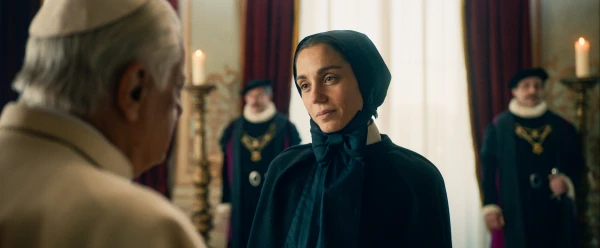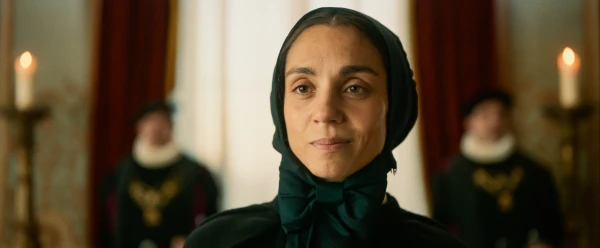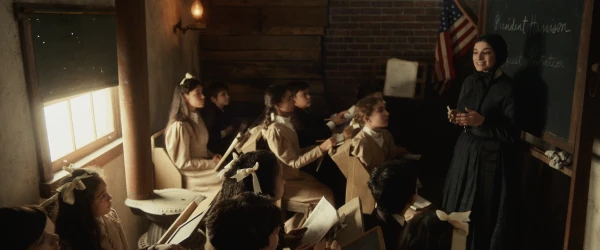National Catholic Register, Mar 6, 2024 / 06:00 am
“During the past few weeks, dark-featured women, in the garb of Sisters of Charity, have been going through the Italian quarters in the Bend and in Little Italy, climbing up dark, steep, and narrow stairways, diving down into foul basements and into dens that even a New York policeman does not care to enter without assistance.
“These women are all slight and delicate. They wear a peculiar veil, unlike that of the usual religious devotees, and few can speak English. They are members of an order entirely new to this country, the Silesian [sic] Missionaries of the Sacred Heart of Jesus. It is an Italian organization of nuns who look after the welfare of orphans and all that are engaged in this work are of Italian birth.”
So begins an article in New York’s The Sun dated June 30, 1889, which also describes Mother Frances Xavier Cabrini as a “sympathetic woman with large coal-black eyes and a winning smile. … She is the founder of the order and has done wonderful work in providing refuges for the orphans in Italy.”
The article even quoted the future saint about her work. “Our object,” she said, “is to rescue the Italian orphans of the city from the misery and dangers that threaten them and to make good men and women of them.”
This real-life milieu inspires “Cabrini,” opening March 8 in movie theaters nationwide.
The movie begins with an incident all too common in late-19th-century New York City: A young Italian immigrant boy desperately pushes his mother lying in a cart, frantically begging for help for the dying woman. Well-dressed upper-class New Yorkers stroll along, ignoring his pleas. The scene transitions to Mother Cabrini (Cristiana Dell’Anna), herself not well, and her nuns in Lombardy, Italy, and then to the Vatican.
When the cardinal assistant to Pope Leo XIII again refuses Mother Cabrini’s request to take her sisters to China, she remembers the time she nearly drowned as a child and overheard the doctor tell her mother: “Your daughter is very weak and would be so as long as she lives. … Now her bed will be her life. That is where she belongs.”
Crucial to her character is her determination that obviously proved the doctor wrong — and an unshakable reliance on Providence as she cares for the orphans and destitute.
Citing an event from the New Testament to convince the cardinal, the determined nun insists on hearing the decision from the Holy Father himself.

Pope Leo (Giancarlo Giannini) is intrigued by her determination and her resolve to not hear “no” for an answer, yet she is always obedient to the Church. The pope permits her to go to the “West,” not to the “East,” in order to care for the orphaned and destitute Italian diaspora in New York.
Giannini, an iconic Italian actor whose career spans nearly six decades, embodies the character of the pope as if it were tailor-made for him. He conveys a quiet authority and deep understanding expected of such a major figure of the Church.
This scene between the pope and religious becomes the exemplar for viewers as they get to know Mother Cabrini, who is depicted as always persistent, resolute, and undaunted, even in the face of severe prejudice. But she unflinchingly responds in ways that have kindness, respect, and love as the foundation of her determination. She is, as St. Paul says of love, never rude. Her ways draw in those who are at first suspicious of her and her motives, like Vittoria, the girl of the streets; and Paolo and his friend, both streetwise orphans.
It also becomes the foundation for the scenes with New York Archbishop Michael Corrigan (David Morse), who decides he does not want the aid of Cabrini or her nuns and tells them to go back to their homeland.
Again, Mother Cabrini visits the pope and goes back with his permission. Before he eventually becomes an admirer of Mother Cabrini, the archbishop tells her she can solicit funds only from the deeply impoverished Italians, not from rich New Yorkers. Tough Mayor Gould (John Lithgow) bullies and threatens the Church leader as a consequence.
Amid all such confrontations, what stands out about Mother Cabrini, as the film highlights, is that she was bold but never rash and impetuous. She was strong yet ever kind to those who vigorously opposed her. She did not argue. She listened and then resourcefully looked for and found a solution that would be agreeable, one way or the other.
(Story continues below)
For Mother Cabrini, what mattered was the good of the people — for their lives were on the line as well as their souls. She was always gentle with children and those in need, wanting them to flourish as good Christians and citizens.
In every instance, Mother Cabrini comes to life in this way through a magnificent Cristiana Dell’Anna in a portrayal that sings of greatness, especially in ways that subtly project Cabrini’s own physical struggles while helping others, her love for the orphan and destitute, and her unshakeable determination in getting help for those in need, even if that meant daring to confront the entire Italian Senate to plead for aid for their countrymen and women in dire straits in America.

Dell’Anna’s performance shines with the inner strength that the real Cabrini, who saw the setbacks as a cross but steadfastly relied on the Lord, exhibited in her holy life. She is part of a cast that works as a rare ensemble, thanks to director Alejandro Monteverde. The visits Mother Cabrini has with Archbishop Corrigan are works of subtle dramatic art, as are those vignettes between the resolute nun and Leo XIII.
Morse, a familiar face of theater, TV, and film (notably “St. Elsewhere,” “Contact,” “The Green Mile”), firmly and convincingly brings out the somewhat hesitant and vacillating archbishop caught between supporting Mother Cabrini and pacifying the mayor. One cannot help but both feel sorry for him and hope that he would support Mother Cabrini fully.
Lithgow, another award-winning veteran of TV, film, and the stage (“3rd Rock From the Sun,” “The Crown,” “Interstellar,” “Life’s Greatest Miracle”), provides additional gravitas to this film. Throughout, Lithgow’s City Hall bullying politics are no match for a composed Cabrini and her polite shrewdness. She outplays and outwits the mayor at his own political game. It leads him to compliment her, describing her by a true line from someone else in her history that will surprise viewers.
Surely a composite figure of many girls Mother Cabrini saved and helped is Vittoria, the street girl who was forced into prostitution (which is suggested but not amplified). Actress Romana Vergano brings out inner goodness waiting for the right person — in this case, Mother Cabrini — to let free. As Vittoria grows in strength and virtue, at a critical moment she spurs her mentor on by recalling something the stalwart nun once told her.
The director, producers, and writers of “Sound of Freedom” used a distinct filming approach. Monteverde, who also directed “Bella” (2006) and “Little Boy” (2015), explained how he considered the story like an opera and choreographed it “so it became like a dance. I shot in a very different way than I’ve shot any other film.” Incidentally, Mother Cabrini liked opera and music.
Monteverde achieves something not only artistic but poetic with his compositions and camerawork. The director’s approach leads to smooth transitions as the film glides along gracefully like the paper boats Cabrini as a young girl made and sailed on pretend “missionary trips.” Indeed, in one of the early scenes, the camera glides slowly along the water and then to the ship, showing the good sisters on their way to serve in America.
Arriving at Five Points in Manhattan, Mother Cabrini and her sisters are confronted with shabby, squalid, and sleazy neighborhoods. The settings are strongly based on the many photographs of these actual slums taken at the time by 19th-century New York journalist and photographer Jacob Riis. The camera gradually glides from the overwhelming slums into a livable home, the nuns’ first step in making a cheerful place for the first children in their care — transitioning from darkness to light.
The symbols of light and dark enhance the story. Sometimes the action goes on in the center, surrounded by the darkness, symbolic of the problems that Mother Cabrini faced, including searching for people living in dank cellars, lantern in hand, conveying she is the light in the darkness for the orphans and abused.

The camera glides, taking Cabrini from her sickbed to a dream of her floating in the water as a child when she almost drowned, and that glide blends into her view through a window: seeing the New York throng. But as the Irish doctor treating her then, who is sympathetic to the immigrants, gives her two or three years to live because of her poor health, her facial expression conveys what she knows from Scripture: She can do all things in Christ, who strengthens her — and goes on to prove it by her work.
Overall, the film focuses on Mother Cabrini’s entrepreneurial skills more than her prayer life. Producer J. Eustace Wolfington, a longtime devotee of Mother Cabrini, was recently quoted as saying: “I would like to get across her leadership, organizational, and entrepreneurial skills.” (Mother Cabrini is also listed as the film’s “Executive Producer.”)
At the same time, at critical moments, Cabrini reminds an aggressor of crucial words in the Scriptures. And she put Matthew 25 into action every day. Mother Cabrini herself saw difficulties as a sign that Jesus was close: “It does not matter what kind of wood the cross is made of. It is enough to know it comes to us from Jesus.”
The credits explain there is some literary license taken. Some parts are dramatized and facts rearranged or relocated.
For example, at one point there was an arson incident in a hospital she was building, but it happened later, and in Chicago, not New York. There is another such incident that is true but happened at a different location. Naturally, jumping from location to location would damage the unity of the drama and be confusing, something this dramatic, highly moving story is not.
This film is a fine tribute to Mother Cabrini and her nuns, themselves facing prejudice, and their tireless work in the foul tenements and essentially invisible locales, bringing help and hope to immigrants in need.
As the basic story of the start of the American mission of Mother Cabrini, “patroness of immigrants,” “Cabrini” proves itself to be an unforgettable, magnificent film that does justice to the unflappable saint, whose life testified to Christ: “The heart of Jesus does things in such a hurry that I can barely keep up with him.”






